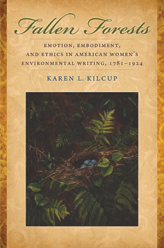Karen L. Kilcup Fallen Forests: Emotion, Embodiment, and Ethics in American Women’s Environmental Writing, 1781-1924 Athens: University of Georgia Press, 2013, 504 pages.
Review by Nicolette Gable
The idea of a book on nineteenth century environmental writing conjures images of Walden Pond and white men of leisure rhapsodizing over sublime scenery. It is pleasantly surprising to read a book that subverts such expectations. In Fallen Forests Karen Kilcup takes on several large projects. First, she seeks to enlarge the scope of what we consider environmental writing and activism. Next, she attempts to shift the discussion of nineteenth century women’s writing from analysis of sentimentalism to the rhetorical use of emotional intelligence. Finally, she seeks to reclaim the discussion of women and nature from essentialism and idealism, by examining material conditions and directly confronting the limitations, contradictions, and failings of these women’s work.
nineteenth century women’s writing from analysis of sentimentalism to the rhetorical use of emotional intelligence. Finally, she seeks to reclaim the discussion of women and nature from essentialism and idealism, by examining material conditions and directly confronting the limitations, contradictions, and failings of these women’s work.
Kilcup considers a wide range of sources, some familiar, some woefully understudied, and combines them in unexpected ways. She also makes sure to attend to voices often ignored. Alongside the environmental moralizing of white protestant women reformers she includes working class, African American, Native-American, and Mexican-American writers. This approach enables her to challenge our understanding of what counts as environmental writing and environmental activism. Considering the works of Pauline Hopkins and Harriet Jacobs in terms of ecocriticism and environmental justice seems at first strange, but the reader quickly becomes convinced of the usefulness of this approach as it renders familiar texts in a new light. Her focus on rhetoric brings many new texts into the realm of intellectual history. What happens when we consider captivity accounts, slave narratives, travel writing, and poetry, as writing intended to persuade in a particular way?
Complicating women’s nature writing is the close association of women with nature and troubled by the dominant Christian discourse of nature as wilderness. Further complicating the terrain are the disparate ways that women of different social positions experienced nature. What to a middle class eastern white woman might be a vision of comfort and nostalgia might be for a slave a vision of danger, fear, and potential freedom. Instead of establishing a master narrative of women’s reactions to nature, Kilcup argues that “women’s experiences of themselves and their ‘natural’ bodies were both culturally superimposed and subjectively experienced, not necessarily in identical ways or with consonant valences. For women of color, older women, the disabled and other outsiders, these connections were intensified, sometimes synergistically. Hence, depending on their background, location, status, attitude toward ‘respectability,’ and literary or political ambitions, writers’ approaches varied; some elided corporeality, whereas others focused almost forensically on material selfhood”(13).
While Kilcup begins by situating her work in and against the fields of nineteenth century women’s literary studies and environmental studies, her methods, sources, and conclusions are relevant to intellectual historians. Her additions to and expansion of the corpus of environmental writing, and her implicit contestation of its established canon, is especially interesting in the context of intellectual history. She participates in the intellectual historian’s ongoing quest to expand who and what counts. Instead of merely considering literature as literature, she broadens our understanding of intellectual history by considering written and spoken sources in terms of rhetoric, attempting to bridge the gap between environmental writing and environmental activism. She argues that emotion, instead of being the opposite or bane of rational thought and argument, is in fact a rhetorical strategy, deployed by women writers. Kilcup investigates how these “affective appeals, juxtaposed to or synthesized with logic and ethics, elicit and educate readers’ emotional intelligence”(10). Indeed, Kilcup argues that emotional intelligence should be taken seriously as a way to communicate, convince others, and perhaps induce changes in thought and action.
After an introduction sketching the historiographical and theoretical grounds for her work, Kilcup’s first chapter examines the nation’s first resource wars that drove Cherokee removal. Using the work of Mary Jemison, Nancy Ward, and Lydia Sigourney Kilcup she questions the place of Christian and sentimental rhetoric in environmentalism by putting Christianity in conversation with Native American religion. Chapter 2 turns the attention to use of trees and forests to compare Caroline Kirkland, Lydia Sigourney, and Harriet Jacobs for their varied reactions to the extractive and progress obsessed nineteenth century. In Chapter 3, Kilcup challenges the idea that eco-criticism must always come from those with enough leisure to travel and enough distance to romanticize nature by examining the works of working class writers Harriet Wilson, Lorenza Stevens Berbineau, and Lucy Larcom. Each presented a view of their environment that reflected their class status, and more importantly, class aspirations, revealing the limitations of a sentimental view of the environment. Chapter 4 turns to consumers, delving into startlingly familiar debates over the ethics of conspicuous consumption. Again the author underlines the split between women of means who are able to advocate a voluntary simplicity, and those to whom “simplicity” and connection to the natural environment is neither voluntary nor safe. Finally, Chapter 5 returns to indigeneity, and moves into the twentieth century, Sarah Winnemucca, Gertrude Bonnin, and Maria Ampara Ruiz de Burton use sentimental, Christian, legal, humorous, and apocalyptic rhetoric to discuss the continuing resource wars. Throughout the book, there is no shying away from pointing out the contradictions and split loyalties of these writers. Racial, class, and other biases and hypocrisies do not, to Kilcup, discredit these works, but rather reveal the complexity and culturally contingent relationship between women and nature. In an afterward, Kilcup links all this to modern environmental rhetoric. Barbara Kingsolver, Jamaica Kincaid, and Winona LaDuke sound remarkably familiar to what we have just read.
The variety of topics, combined with Kilcup’s close attention to detail means that her central themes are sometimes lost. Furthermore, the myriad ways in which she interprets “environmental” threaten to strip the word of all meaning, putting almost all women’s writing within her scope. Given this breadth, the book’s movement through time, and her focus on rhetoric, the reader occasionally feels disoriented historically. Seventy-eight pages of notes and an ample bibliography ameliorate this problem. Of course, one book cannot cover everything and Fallen Forests’ virtues far outweigh these inevitable problems.
The sheer breadth of topics that Kilcup ties together is enough to recommend the book to intellectual historians. Methodologically, her ability to tie feminist embodiment theory and emotional intelligence seamlessly with close reading of texts and to make rhetorical analysis a pleasure to read is admirable. Its greatest value lies in its expansion of environmental writing which opens up this field, and many others, to radical new readings and reminds us that even the most familiar texts can be read in a new light.

Nicolette Gable is a PhD Candidate in the American Studies Program at the College of William and Mary. She is currently working on her dissertation on the Decadent movement in America at the end of the nineteenth century.

0